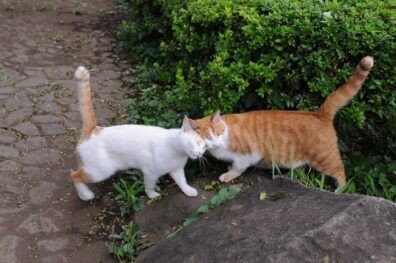Have you ever watched your cat lovingly rub their face against furniture, your legs, or even their favorite toys and wondered, “Why Do Cats Rub Their Face On Things?” It’s a common and endearing behavior, and as a content creator for why.edu.vn, I’m here to decode this feline mystery for you. Let’s dive into the fascinating world of cat communication and explore the reasons behind this curious rubbing ritual.
Cats use a complex system of communication, and scent plays a vital role in their interactions. When you observe your cat rubbing their face on objects, they are actually engaging in a behavior known as scent marking. This isn’t just random affection; it’s a sophisticated way for them to leave their personal signature on their environment and the things they consider important.
The Secret Weapon: Scent Glands and Pheromones
The key to understanding this behavior lies in specialized structures called scent glands. Cats are equipped with these glands in several areas of their bodies, including their cheeks, chin, forehead, paws, and near their tail. These glands produce and release chemical messengers called pheromones.
Pheromones are like invisible signals that cats use to communicate with each other and understand their surroundings. They are species-specific, meaning cat pheromones primarily affect other cats. These chemical signals convey a range of information, from social status and reproductive status to feelings of safety and comfort.
Facial Scent Glands: Happy Markers
When it comes to facial rubbing, the scent glands located in a cat’s cheeks, lips, and forehead are particularly important. These facial glands release a specific type of pheromone known as feline facial pheromones. These pheromones are often associated with positive emotions and territorial marking.
According to veterinary expert Dr. Jessica Bell from Washington State University, cats rub their cheeks on things “when they’re happy or want to say that thing belongs to them.” This explains why your cat might rub against you when you come home – they are not only greeting you but also marking you as a safe and familiar part of their world. They might also rub on doorways, furniture, or their food bowls, essentially claiming these areas as their secure and comfortable territory.
 Two tabby cats exhibiting bunting behavior by rubbing faces, a form of feline facial pheromone marking for social bonding and territory declaration.
Two tabby cats exhibiting bunting behavior by rubbing faces, a form of feline facial pheromone marking for social bonding and territory declaration.
This scent marking behavior isn’t aggressive or territorial in a negative sense. Instead, it’s more about creating a sense of familiarity and security. By depositing their scent, cats are essentially saying, “I feel safe and comfortable here,” or “This is mine and I feel good about it.”
More Than Just Rubbing: Bunting and Allorubbing
Beyond the typical facial rubbing, there are other related behaviors that cats exhibit. One such behavior is called “bunting.” Bunting is when cats greet each other, or even their favorite humans, by gently bumping their heads together or rubbing their faces against each other. Dr. Bell describes bunting as “like a high five, a hug and a chat all in one,” highlighting its social and affectionate nature.
Another related behavior is “allorubbing,” which is when two cats who are familiar and friendly with each other rub their bodies against one another. These behaviors further emphasize the social communication aspect of feline scent marking.
The Science of Scent Detection: Vomeronasal Organ and Flehmen Response
Cats don’t just rely on their noses to detect pheromones. They have a specialized olfactory organ called the vomeronasal organ (VNO), also known as Jacobson’s organ. This organ is located in the roof of their mouth and is specifically designed to detect pheromones and other non-volatile scent molecules.
When a cat encounters an interesting scent, particularly pheromones, they may exhibit a peculiar facial expression called the “Flehmen response.” This involves opening their mouth slightly, curling back their lips, lifting their head, and sometimes extending their tongue. This grimace-like expression helps to draw the scent molecules into the VNO, allowing for a more detailed “scent analysis.” As Dr. Universe aptly describes it, Flehmen’s response is like “taking a big sniff with your mouth.”
Artificial Pheromones: Calming Scents for Cats
Understanding the power of feline facial pheromones has led to the development of artificial pheromone products. These products, available as sprays or diffusers, mimic the natural pheromones that cats use to mark safe and comfortable environments.
Veterinarians like Dr. Bell utilize these artificial pheromones in clinics to reduce stress in cats. “We use pheromones on our blankets and kennels in the veterinary clinic,” she explains. “We sometimes use it in our exam rooms to help reduce the overall stress load on the cat—or how they interpret the stress.” These pheromone products can be beneficial in various situations, such as introducing a cat to a new home, during travel, or in multi-cat households to reduce tension.
Decoding Your Cat’s Rubs
So, the next time you see your cat rubbing their face on things, remember that it’s more than just a random act. It’s a complex form of communication, a way of marking their territory, expressing happiness, and creating a sense of security. By understanding this behavior, we gain a deeper appreciation for the intricate world of our feline companions and the subtle ways they interact with their environment and us.